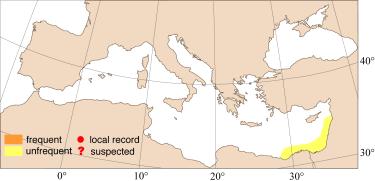
|
Relevant synonyms
Misidentification
Meristic formula
|
|
| photo : John E. Randall |
|
SHORT
DESCRIPTION
color :
back brown grey with whitish belly. Several dark bars on the back of most specimens. Numerous dark spots and blotches on pectoral and pelvic fins. Two (rarely, three) distinct black stripes on caudal fin.
size :
common 30-50 cm (max. 70 cm). |
DISTINGUISHING CHARACTERISTICS
BIOLOGY / ECOLOGY
habitat : benthic on sandy or muddy substrate to depth of 40 m. Euryhaline species reported to penetrate estuaries. |
|
1st
MEDITERRANEAN RECORD
|

|
|
DISTRIBUTION
|
ESTABLISHMENT SUCCESS
speculated reasons for success :
|
|
|
MODE OF
INTRODUCTION |
IMPORTANCE TO
HUMANS |
|
KEY
REFERENCES
|